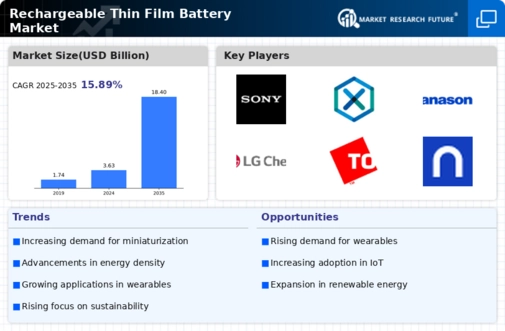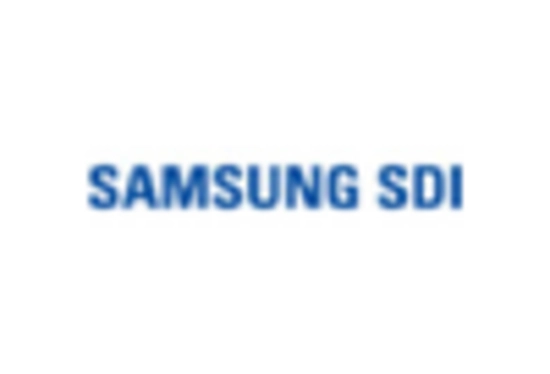Growing Electric Vehicle Adoption
The Rechargeable Thin Film Battery Market is significantly influenced by the growing adoption of electric vehicles (EVs). As governments and consumers alike prioritize sustainable transportation solutions, the demand for efficient and lightweight batteries is escalating. Thin film batteries, with their potential for high energy density and rapid charging capabilities, are well-positioned to meet the needs of the EV market. Recent projections suggest that the EV market could reach a valuation of over 800 billion by 2027, with thin film batteries playing a crucial role in this transition. This shift towards electric mobility is likely to spur investments in battery technology, further propelling the growth of the rechargeable thin film battery sector.
Rising Demand for Portable Electronics
The Rechargeable Thin Film Battery Market is witnessing a notable increase in demand for portable electronic devices. As consumers increasingly rely on smartphones, tablets, and wearable technology, the need for lightweight and high-capacity batteries becomes paramount. Thin film batteries offer a unique advantage due to their slim profile and flexibility, making them ideal for integration into various devices. Market data indicates that the portable electronics segment is expected to account for over 40% of the total market share by 2026. This trend is likely to drive manufacturers to invest in research and development to create batteries that not only meet but exceed consumer expectations for performance and longevity.
Advancements in Manufacturing Techniques
The Rechargeable Thin Film Battery Market is also being driven by advancements in manufacturing techniques. Innovations such as roll-to-roll processing and improved deposition methods are enabling the production of thin film batteries at a lower cost and with higher efficiency. These advancements not only reduce production costs but also enhance the scalability of battery manufacturing. As a result, the market is likely to see an influx of new players and increased competition, which could lead to further innovations and price reductions. Current estimates suggest that the manufacturing sector for thin film batteries could expand by 30% over the next few years, reflecting the growing interest in this technology.
Technological Innovations in Energy Storage
The Rechargeable Thin Film Battery Market is experiencing a surge in technological innovations that enhance energy storage capabilities. Recent advancements in materials science, particularly the development of new electrode materials, have led to batteries that are lighter, more efficient, and capable of faster charging. For instance, the introduction of lithium-sulfur and solid-state technologies is expected to improve energy density significantly. As a result, the market is projected to grow at a compound annual growth rate of approximately 20% over the next five years. This growth is driven by the increasing demand for compact and efficient energy solutions in consumer electronics and electric vehicles, where performance and weight are critical factors.
Increased Focus on Renewable Energy Solutions
The Rechargeable Thin Film Battery Market is benefiting from an increased focus on renewable energy solutions. As the world shifts towards sustainable energy sources, the need for efficient energy storage systems becomes critical. Thin film batteries are particularly suited for applications in solar and wind energy systems, where they can store excess energy for later use. Market analysis indicates that the renewable energy sector is expected to grow at a rate of 15% annually, creating a substantial opportunity for thin film battery manufacturers. This trend underscores the importance of developing energy storage technologies that can support the integration of renewable sources into the energy grid.

















Leave a Comment